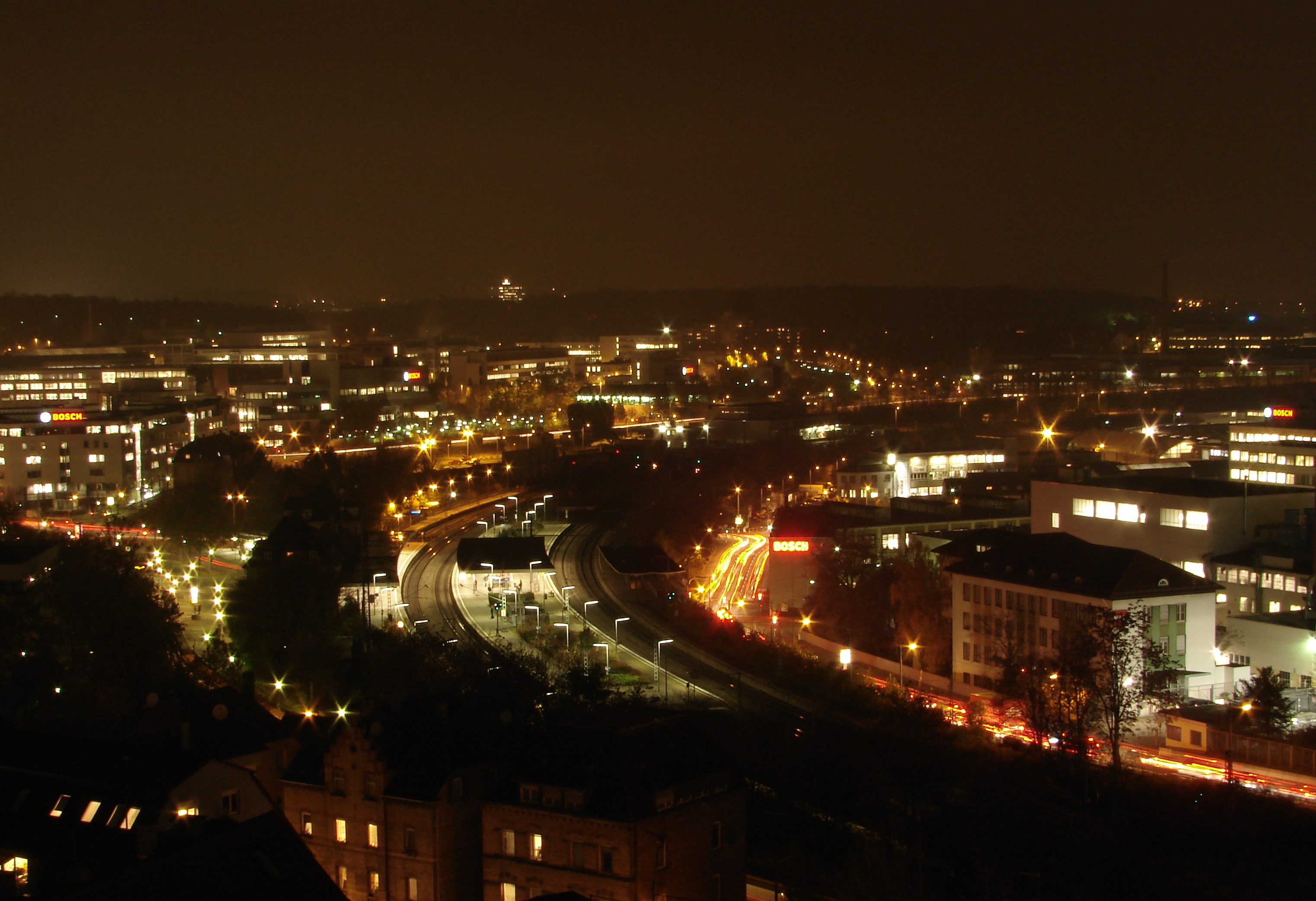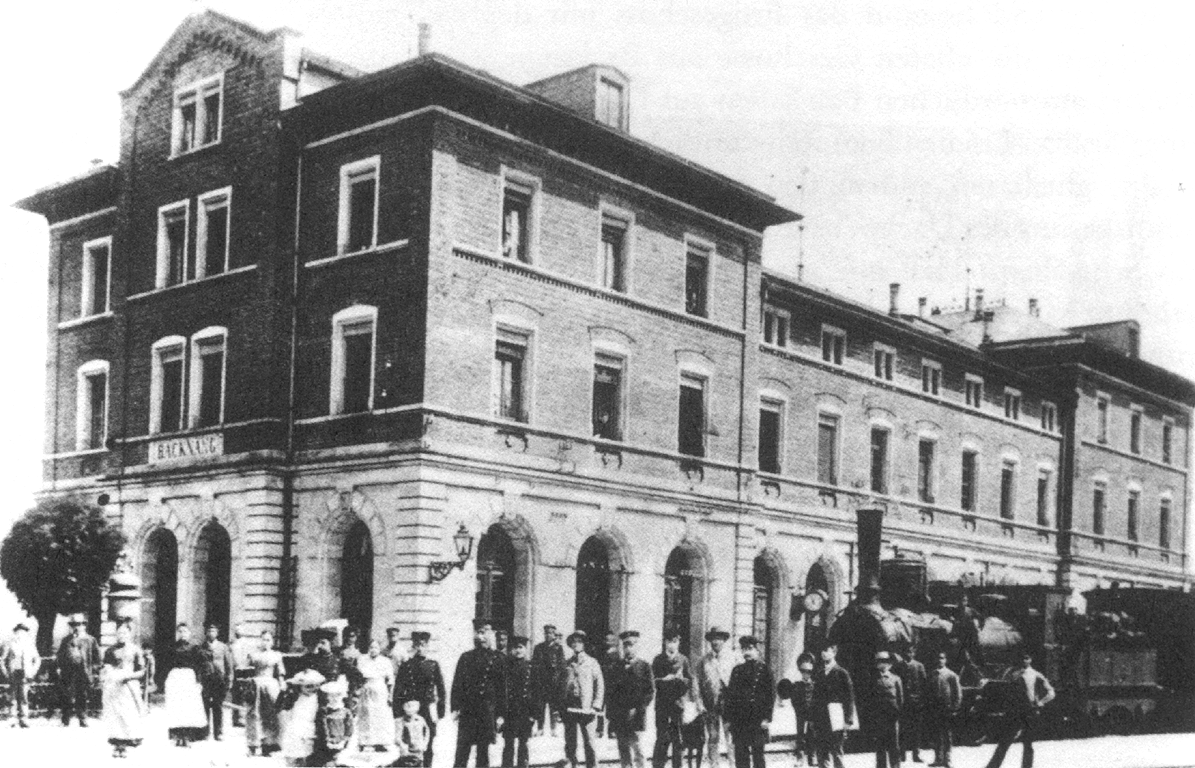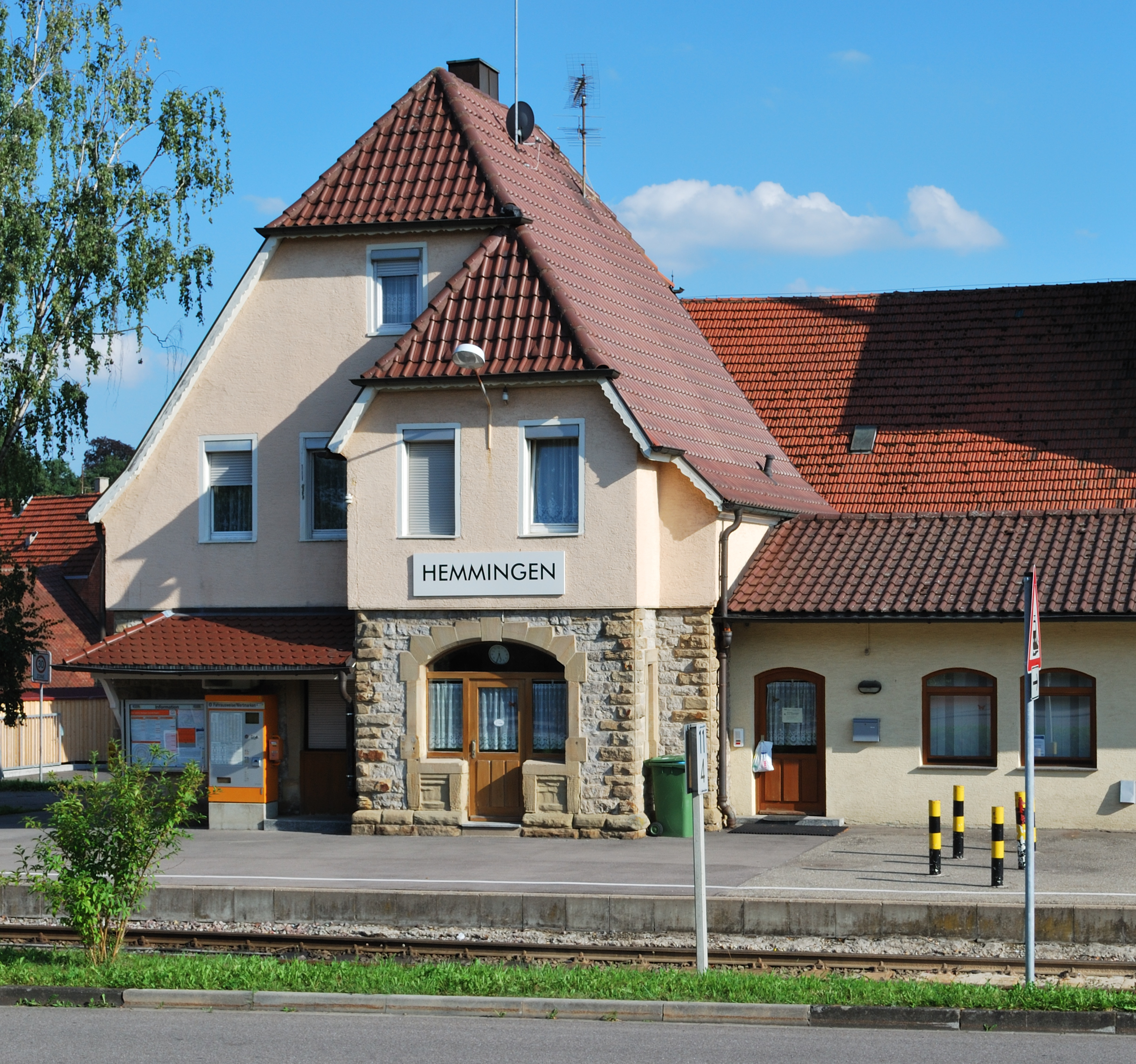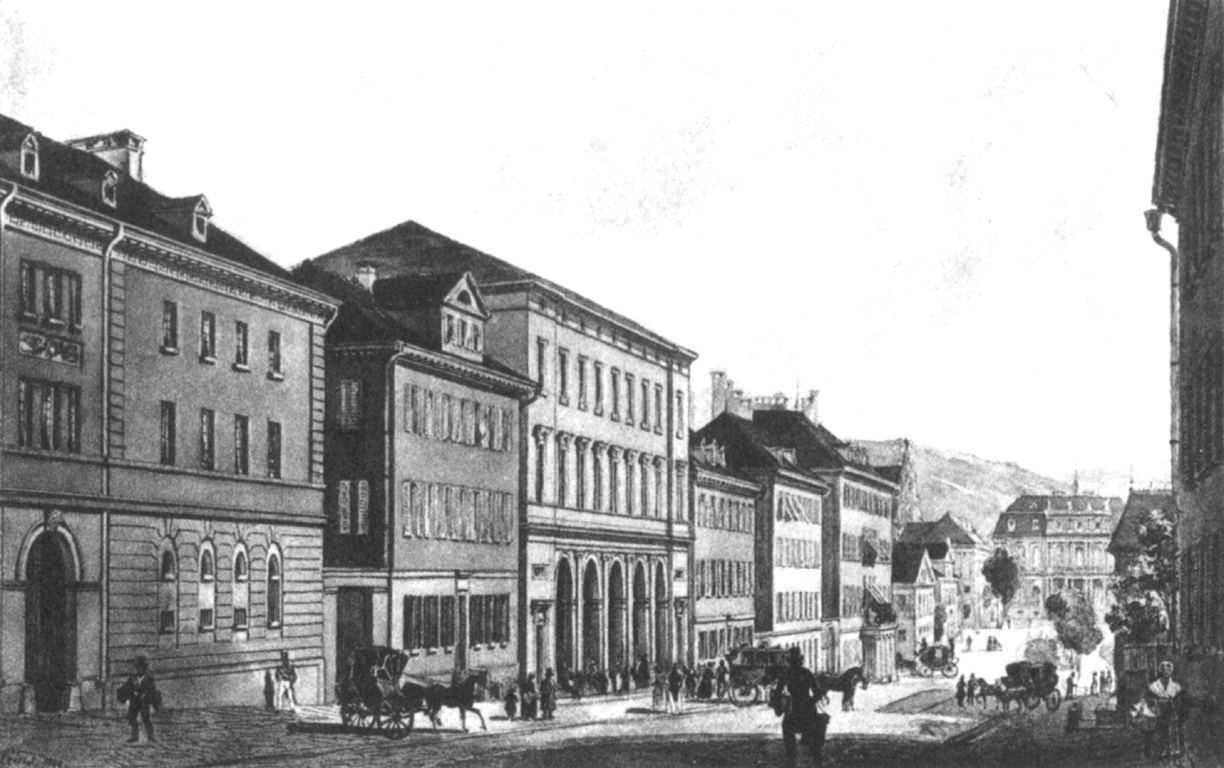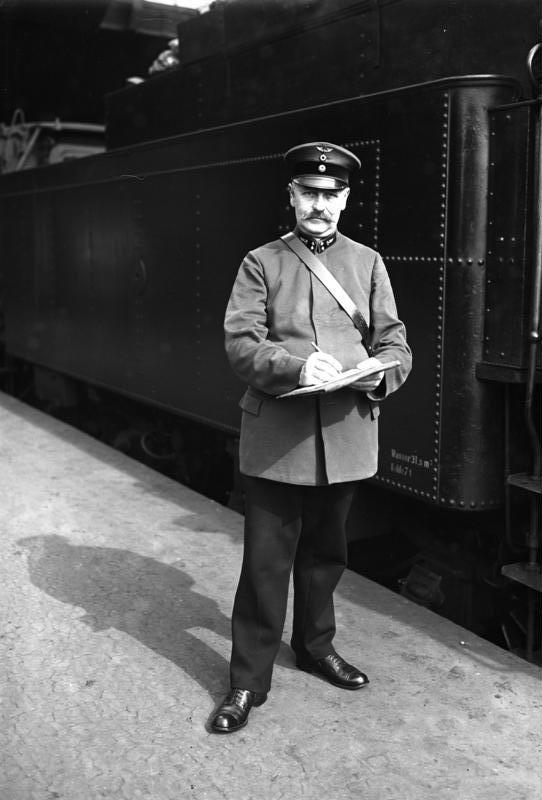|
Stuttgart-Feuerbach Station
Feuerbach station is an S-Bahn station in the Stuttgart borough of Feuerbach in the German state of Baden-Württemberg. It is on the Franconia Railway. The station is classified by Deutsche Bahn as a category 4 station and is classified as a ''haltepunkt'' (halt) because it now has no operable sets of points. History Feuerbach station was opened by the Royal Württemberg State Railways (german: Königlich Württembergische Staatsbahn) along with the Central Railway (''Centralbahn'') from Stuttgart to Ludwigsburg on 15 October 1846. It is one of the oldest stations in Württemberg. At that time it was about a kilometre outside the village, along the road towards Cannstatt. The old one-story station building was erected about 200 metres from the Prag Tunnel. File:Bahnhof Stuttgart-Feuerbach Ende 19 Jhdt.png, Feuerbach station after reconstruction in 1871–1872 with the Prag Tunnel in the background File:Bahnhof Stuttgart-Feuerbach 1909.png, Station building from 1909, town side ... [...More Info...] [...Related Items...] OR: [Wikipedia] [Google] [Baidu] |
Stuttgart-Feuerbach
Feuerbach is a borough (''Stadtbezirk'') of the city of Stuttgart. Its name is derived from the small river of the same name that flows from the neighboring district of Botnang through Feuerbach. Feuerbach is home to one of Germany's biggest industrial giants and is surrounded by the districts of Zuffenhausen, Bad Cannstatt, Stuttgart-North, Stuttgart-West, Botnang and Weilimdorf. History The remains of a prehistoric settlement were uncovered in 1904, when the pastor of Feuerbach, Richard Kallee excavated, archeologically documented and published a total of 102 Alemannic sandstone tombs and cists. Heinz Krämer: Fertig Feuerbach! Richard Kallee, Pfarrer und Geschichtsforscher '' in German, DRW Verlag, Leinfelden-Echterdingen, 2004, . Was die alten Steine in Feuerbach erzählen'' in German, 1923. Together with his helpers he took great care to recover 760 artifacts from these Alemannic graves: skulls and bones, coins, pottery shards, combs, necklaces, belts, locks, swords, sp ... [...More Info...] [...Related Items...] OR: [Wikipedia] [Google] [Baidu] |
Württemberg
Württemberg ( ; ) is a historical German territory roughly corresponding to the cultural and linguistic region of Swabia. The main town of the region is Stuttgart. Together with Baden and Hohenzollern, two other historical territories, Württemberg now forms the Federal State of Baden-Württemberg. Württemberg was formerly also spelled Würtemberg and Wirtemberg. History Originally part of the old Duchy of Swabia, its history can be summarized in the following periods: *County of Württemberg (1083–1495) * Duchy of Württemberg (1495–1803) *Electorate of Württemberg (1803–1806) *Kingdom of Württemberg (1806–1918) *Free People's State of Württemberg (1918–1945) After World War II, it was split into Württemberg-Baden and Württemberg-Hohenzollern due to the different occupation zones of the United States and France. Finally, in 1952, it was integrated into Baden-Württemberg. Stuttgart, the historical capital city of Württemberg, became the capital of the p ... [...More Info...] [...Related Items...] OR: [Wikipedia] [Google] [Baidu] |
Marbach (Neckar) Station
Marbach (Neckar) station serves the town of Marbach in the German state of Baden-Württemberg. It is the terminus for line S 4 of the Stuttgart S-Bahn and Regionalbahn trains from Backnang. Until 1966, this was the starting point of the Bottwar Valley Railway (''Bottwartalbahn''), which ran all the way to Heilbronn Süd station. History The Backnang–Bietigheim line was built by the Royal Württemberg State Railways as part of a new east–west link from the Bavarian border at Crailsheim to the Baden border at Mühlacker. The town council of Marbach had long petitioned the government for a connection to the railway network, which the new line would provide. Construction began in 1875. A huge iron truss viaduct with sandstone pillars was built over the Neckar valley between Marbach and Benningen. The station was built about half a kilometre northeast of the centre of the town. The station building, which is still preserved, was more impressive than the others on the line. The c ... [...More Info...] [...Related Items...] OR: [Wikipedia] [Google] [Baidu] |
Backnang Station
Backnang station is located on the Waiblingen–Schwäbisch Hall railway and is the starting point of the Backnang–Ludwigsburg railway in the city of Backnang in the German state of Baden-Württemberg. It is served by Regional-Express services. It is the terminus of lines S 3 and S 4 of the Stuttgart S-Bahn. It is classified by Deutsche Bahn as a category 3 station. History In the 1860s, the citizens of the Oberamt (district) of Backnang sought a connection to the rail network. In 1863, the Backnang trade association, together with trade associations in other towns, wrote a petition to the Württemberg ministry of foreign affairs, which was then in charge of railway construction. By the autumn engineers had travelled to the area to make surveys. State Railways and Deutsche Reichsbahn periods On 26 October 1876, the Royal Württemberg State Railways (german: Königlich Württembergischen Staats-Eisenbahnen) opened the Murr Valley Railway between Waiblingen and Backnang. The ... [...More Info...] [...Related Items...] OR: [Wikipedia] [Google] [Baidu] |
Strohgäu Railway
The Strohgäu Railway (german: Strohgäubahn) is a branch line in the Stuttgart region of the Germany, German state of Baden-Württemberg. It is single-track and standard gauge, and is long. It links Weissach and Hemmingen (Württemberg), Hemmingen with Korntal, where a connection is made with line S6 of the Stuttgart S-Bahn, which provides a direct service to Stuttgart. The ''Strohgäubahn'' is owned and operated by the Württembergische Eisenbahn-Gesellschaft (WEG), a member of the Veolia Transport group. The line dates back to 1906, when it was originally opened by WEG. Passenger services on the ''Strohgäubahn'' use Stadler Regio-Shuttle RS1 units with a partial low floor. The typical service pattern consists of two trains an hour between Heimerdingen and Korntal, although the frequency may reduce to one train an hour on Sundays. The segment between Heimerdingen and Weissach is currently not operated regularly. Until December 2012, trains were extended during peak periods ... [...More Info...] [...Related Items...] OR: [Wikipedia] [Google] [Baidu] |
Württembergische Eisenbahn-Gesellschaft
The Württembergische Eisenbahn-Gesellschaft ("Württemberg Railway Company") or WEG is a transport company in southwest Germany that operates railway lines and services. It is owned by Transdev Germany, itself a subsidiary of the Transdev group. Historically, WEG also operated bus services in the area of its rail services, and WEG branded buses still operate in these areas. However, since 2008 these services have been operated by Omnibus-Verkehr Ruoff GmbH, another subsidiary of Veolia Verkehr GmbH. Lines WEG provides passenger train services on the following railway lines: * : '' Schönbuchbahn'' between Dettenhausen and Böblingen * : '' Strohgäubahn'' between Weissach and Korntal * : '' Wieslauftalbahn'' between Rudersberg- Oberndorf and Schorndorf * : '' Tälesbahn'' between Neuffen and Nürtingen WEG owns and maintains the infrastructure of the ''Strohgäubahn'' and the ''Tälesbahn'', whilst on the ''Schönbuchbahn'' and ''Wieslauftalbahn'' it maintains the infra ... [...More Info...] [...Related Items...] OR: [Wikipedia] [Google] [Baidu] |
Stuttgart-Feuerbach Pragtunnel 20060621
Feuerbach is a borough (''Stadtbezirk'') of the city of Stuttgart. Its name is derived from the small river of the same name that flows from the neighboring district of Botnang through Feuerbach. Feuerbach is home to one of Germany's biggest industrial giants and is surrounded by the districts of Zuffenhausen, Bad Cannstatt, Stuttgart-North, Stuttgart-West, Botnang and Weilimdorf. History The remains of a prehistoric settlement were uncovered in 1904, when the pastor of Feuerbach, Richard Kallee excavated, archeologically documented and published a total of 102 Alemannic sandstone tombs and cists. Heinz Krämer: Fertig Feuerbach! Richard Kallee, Pfarrer und Geschichtsforscher '' in German, DRW Verlag, Leinfelden-Echterdingen, 2004, . Was die alten Steine in Feuerbach erzählen'' in German, 1923. Together with his helpers he took great care to recover 760 artifacts from these Alemannic graves: skulls and bones, coins, pottery shards, combs, necklaces, belts, locks, swords, spears ... [...More Info...] [...Related Items...] OR: [Wikipedia] [Google] [Baidu] |
Stuttgart-Feuerbach Bf Gleisseite 20060621
Feuerbach is a borough (''Stadtbezirk'') of the city of Stuttgart. Its name is derived from the small river of the same name that flows from the neighboring district of Botnang through Feuerbach. Feuerbach is home to one of Germany's biggest industrial giants and is surrounded by the districts of Zuffenhausen, Bad Cannstatt, Stuttgart-North, Stuttgart-West, Botnang and Weilimdorf. History The remains of a prehistoric settlement were uncovered in 1904, when the pastor of Feuerbach, Richard Kallee excavated, archeologically documented and published a total of 102 Alemannic sandstone tombs and cists. Heinz Krämer: Fertig Feuerbach! Richard Kallee, Pfarrer und Geschichtsforscher '' in German, DRW Verlag, Leinfelden-Echterdingen, 2004, . Was die alten Steine in Feuerbach erzählen'' in German, 1923. Together with his helpers he took great care to recover 760 artifacts from these Alemannic graves: skulls and bones, coins, pottery shards, combs, necklaces, belts, locks, swords, spears ... [...More Info...] [...Related Items...] OR: [Wikipedia] [Google] [Baidu] |
Stuttgart 21
Stuttgart 21 is a railway and urban development project in Stuttgart, Germany. It is a part of the Stuttgart–Augsburg new and upgraded railway and the Main Line for Europe (Paris—Vienna) within the framework of the Trans-European Networks. Its core is a renewed Stuttgart Hauptbahnhof, among some of new railways, including some of tunnels and of high-speed lines. The project was officially announced in April 1994. Construction work began on 2 February 2010. In March 2013, total costs were officially estimated at €6.5 billion, the previous estimate being €4.5 billion in 2009. In March 2022, Deutsche Bahn estimated the total cost at €9.15 billion. Heated debate ensued on a broad range of issues, including the relative costs and benefits, geological and environmental concerns, as well as performance issues. As of 2019, the start of operation is expected in late 2025, versus an initial estimation of 2019 (made in 2010). Concept The concept attempts to combine pla ... [...More Info...] [...Related Items...] OR: [Wikipedia] [Google] [Baidu] |
Stuttgart Central Station
Stuttgart Hauptbahnhof (; en, Stuttgart central station) is the primary railway station in the city of Stuttgart, the state capital of Baden-Württemberg, in southwestern Germany. It is the largest regional and long-distance railway station in Stuttgart, the main node of the Stuttgart S-Bahn network, and, together with the station at Charlottenplatz, it is the main node of the Stuttgart Stadtbahn. Located at the northeastern end of the ''Königstraße'', the main pedestrian zone of the city centre, the main line station is a terminus, whilst the subterranean S-Bahn and Stadtbahn stations are through-stations. The station is well known for its 12-storey tower with a large, rotating and illuminated Mercedes-Benz star insignia on top; the tower and station building are city landmarks. Plans for the controversial Stuttgart 21 project to convert the main line terminus station into an underground through station include the demolition of the side wings of the building, together wi ... [...More Info...] [...Related Items...] OR: [Wikipedia] [Google] [Baidu] |
Deutsche Reichsbahn
The ''Deutsche Reichsbahn'', also known as the German National Railway, the German State Railway, German Reich Railway, and the German Imperial Railway, was the German national railway system created after the end of World War I from the regional railways of the individual states of the German Empire. The ''Deutsche Reichsbahn'' has been described as "the largest enterprise in the capitalist world in the years between 1920 and 1932"; nevertheless its importance "arises primarily from the fact that the Reichsbahn was at the center of events in a period of great turmoil in German history". Overview The company was founded on 1 April 1920 as the ("German Imperial Railways") when the Weimar Republic, which still used the nation-state term of the previous monarchy, (German Reich, hence the usage of the in the name of the railway; the monarchical term was ), took national control of the German railways, which had previously been run by the German states. In 1924 it was reorganise ... [...More Info...] [...Related Items...] OR: [Wikipedia] [Google] [Baidu] |
Quinine
Quinine is a medication used to treat malaria and babesiosis. This includes the treatment of malaria due to ''Plasmodium falciparum'' that is resistant to chloroquine when artesunate is not available. While sometimes used for nocturnal leg cramps, quinine is not recommended for this purpose due to the risk of serious side effects. It can be taken by mouth or intravenously. Malaria resistance to quinine occurs in certain areas of the world. Quinine is also used as an ingredient in tonic water to impart a bitter taste. Common side effects include headache, ringing in the ears, vision issues, and sweating. More severe side effects include deafness, low blood platelets, and an irregular heartbeat. Use can make one more prone to sunburn. While it is unclear if use during pregnancy causes harm to the baby, treating malaria during pregnancy with quinine when appropriate is still recommended. Quinine is an alkaloid, a naturally occurring chemical compound. How it works as a medicin ... [...More Info...] [...Related Items...] OR: [Wikipedia] [Google] [Baidu] |

